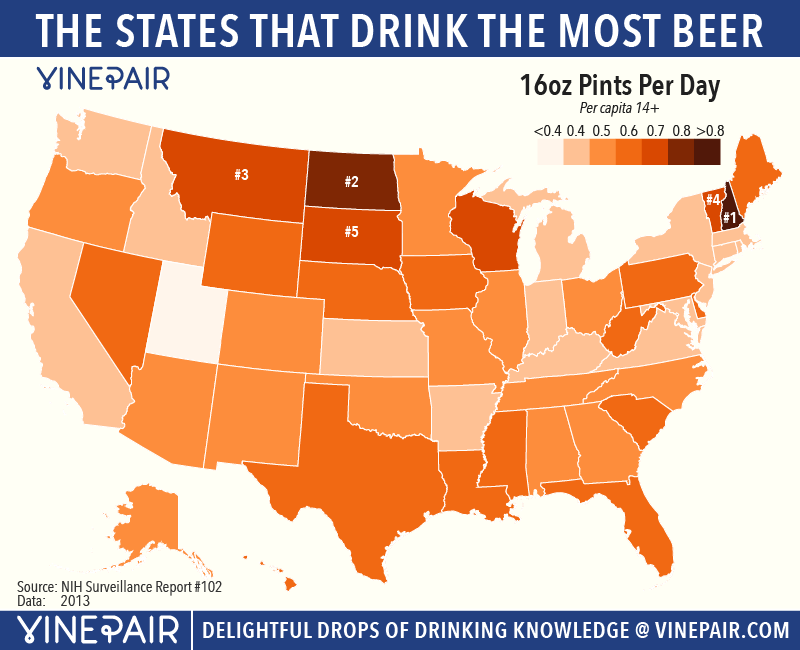The units on this map made me do a double-take, and wonder if this wasn't something about motor fuels.
A pint of beer contains a little more than a tablespoon of ethanol, and I suppose it adds up, but two gallons per year? Heavy consumers must be pushing up the average, as only 56% of Americans aged 18 or over reported consuming during the previous month, 70% during the previous year. Internationally, "almost half of all men and two thirds of all women worldwide have abstained from drinking alcohol in the past 12 months." PDF
Dr. Dawson is perhaps not addressing abstainers, and his grandiose title might well be continued "...if you are the sort of person likely to end up in my office seeking treatment," though he does point out that "none of the people with addictions who I talk to ever started out believing that one day they would end up with an alcohol or drug use problem."
He offers ten mediocre pro-alcohol arguments answered by ten mediocre counterarguments. None of them are especially convincing, but I've never been able to come up with a conclusive argument to justify the half-gallon or so of brain-function-inhibitor I estimate I consume in a year. There are plenty of sites that present the wide array of social and policy costs, mostly are caused by "problem drinkers," not me. (I am also among the 80% of drivers who rate themselves in the top 30% for safety.)
He also omits the financial cost to consumers, which as blackbootz mentioned can be substantial.
This sentence left me a little confused:
- My blog is one of the few places where you can see a graphic of how things went during prohibition and it obviously wasn't good.
The usual story is that prohibition was a disaster because bootleggers did more harm than the alcohol, and didn't even pay taxes. The chart seems to suggest that there was a decline in alcohol-related bad consequences early in Prohibition (1920 to 1933) but the benefits didn't last, or something.
While denying the "prohibitionist" slur, Dawson supports legal restrictions on potentially harmful substances. This was also the case with his earlier piece on opiates:
Exploitation Of Opiate Addicts - Same Song Different Century
Curiously, he cited an addiction rate of about 1% while opiates were relatively unregulated:
- By 1920 there was one estimate that there were a million opiate addicts in the United States. The population at the time was about 107 million people.
A century later, the opioid epidemic has resulted in 2.1 million people with an opioid use disorder, 0.65% of the population. Regulation has not been a silver bullet.
No doubt people will continue putting things in their bodies and doctors will continue to disapprove, and it will never be cool to point out that "you can go through life without ever taking a drink."
I'm not sure why he uses a black'n'white NIH surveillance report when it's totally in color and updated less than a year ago. of course, that report also says a healthy goal is 2.1 gallons per capita per year, not zero. "VinePair", whoever they are, broke the data down to real terms for beer, wine and spirits:
For people over 14, the heaviest wine-drinking state (Idaho! who knew!) average half a glass of wine a day. The heaviest beer-drinking state (New Hampshire) averages less than a can a day. The heaviest consumer of liquor (New Hampshire!) averages less than a shot a day. And then you gotta consider guys like my dad who will kill a half-rack of Coors Light between noon and 9 because apparently he likes to pee a lot. That's gonna push the quota lower for a whole buncha folx.
Nowhere in the good doctor's treatise does he acknowledge the reason people drink: we like it. Humans have a long and storied tradition of inebriants of all kinds that are nearly inseparable from most cultures. As a species, we fundamentally alter our brain chemistry on a regular basis. Lots of people can't handle that and it can ruin their lives but lots more people have no difficulty with it. nowhere in his seven deadly reasons does he include "it's a fun thing I drink with my friends" or even "it's a fun thing I drink while playing XBox." Astonishingly enough, ctrl-f "fun" fails out on that entire page, which highlights what an incomplete argument is being made.
Prohibition is considered a failure because it did effectively nothing to consumption levels (a fact noted in the working paper linked by the author). What it changed was consumption patterns - it made alcohol more expensive, drove down quality control, and fostered a thriving black market largely tolerated by law enforcement because the public was not fundamentally against alcohol. Worthy of note: whisky was 80 proof then, it was 80 proof 100 years before then and it'll be 80 proof 100 years from now. Booze be booze, man. Opioids? not the same. Opium is one thing. Heroin is quite another. And, as a much more severe intoxicant than alcohol, its usage patterns are far more prone to social changes. You can drink a beer and go fishing with your buddies. You don't usually shoot up and do the same. Casual users of alcohol vastly outnumber addicts; the opposite is true of opioids.
You can go through life without ever taking a drink, and if that's the choice you make, good on ya. Those of us who make other choices, however, deserve the courtesy of having our arguments addressed, rather than those of any convenient straw man.
posted 2216 days ago


